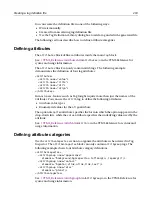
214
Chapter 14 Customizing the Development Environment
Building a custom wizard
This section describes how to collects information from a user with a wizard.
Wizards are an integral part of many software products because they enable users to
perform complex tasks in an orderly, comprehensible user interface. Also, a
well-designed wizard controls its input and ensures a high probability of user
success.
H for Dreamweaver MX includes a number of wizards, and you can create
your own with the Wizard Markup Language (WIZML). If you have worked with
VTML to create or edit tag dialog boxes, you are familiar with building user interface
containers and controls and with defining page layout. You can use these skills to
add wizards to your applications.
To create a wizard:
1
Write a wizard definition (VTM) file to specify the pages, parameters, output, and
logical flow.
2
Implement one or more output template (WML) files for the wizard.
3
Create wizard graphic (BMP) files.
Each of these steps is described in detail in the following sections.
The recommended way to organize wizards and supporting files is to save the vtm
and wml files in the \Wizards\Custom folder and to save the image files in the
\Wizards\Images folder of your H for Dreamweaver MX directory.
Summary of Contents for HOMESITE
Page 11: ...Contents xi Table of CommandID values 310 Table of SettingID values 314 Glossary 323...
Page 12: ...xii Contents...
Page 20: ...xx About This Book...
Page 28: ...8 Chapter 1 Setting Up the Product...
Page 70: ...50 Chapter 4 Managing Files...
Page 88: ...68 Chapter 5 Writing Code and Web Content...
Page 116: ...96 Chapter 6 Editing Pages...
Page 148: ...128 Chapter 7 Using Web Development Languages...
Page 190: ...170 Chapter 11 Deploying Files...
Page 210: ...190 Chapter 12 Testing and Maintaining Web Pages...
Page 216: ...196 Chapter 13 Extending the Help System...
Page 350: ...330 Glossary...
Page 358: ...338 Index...
















































